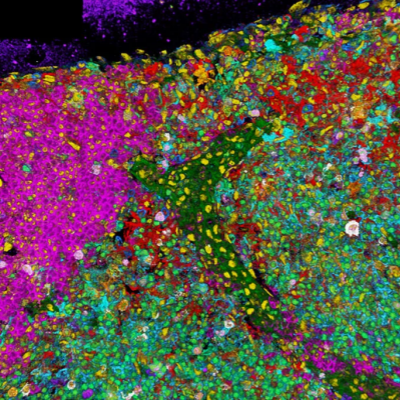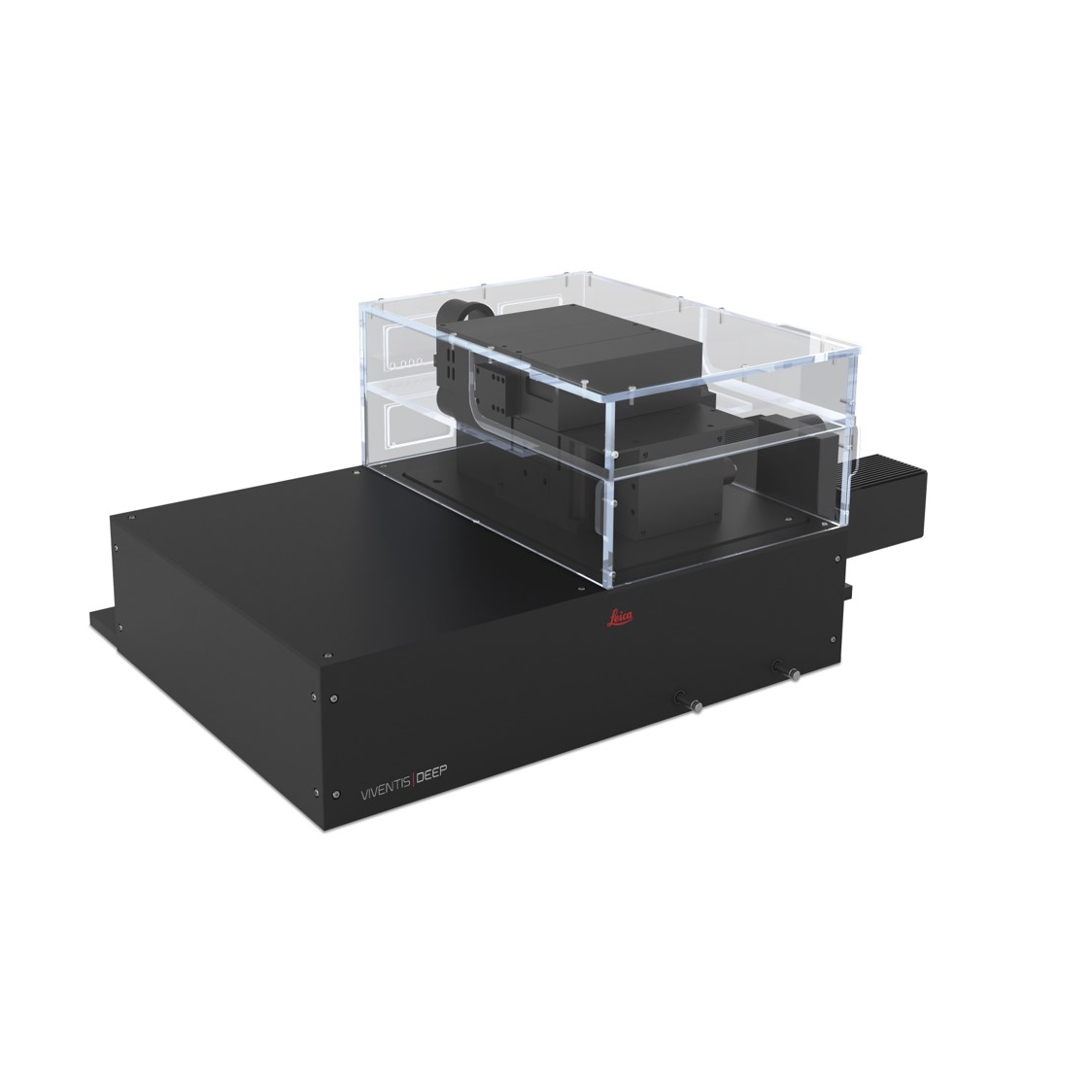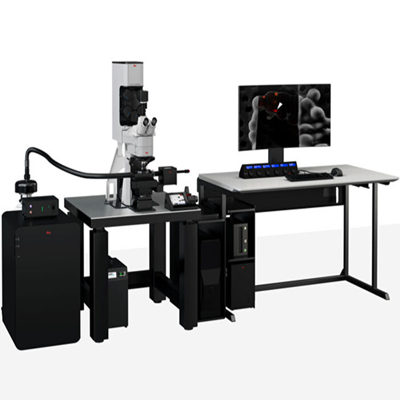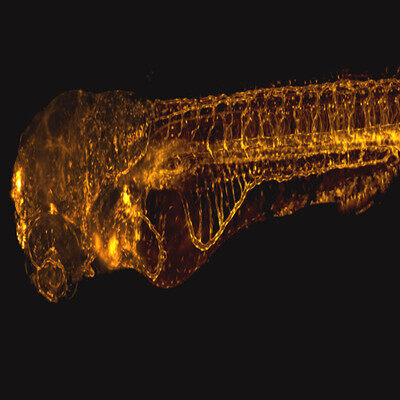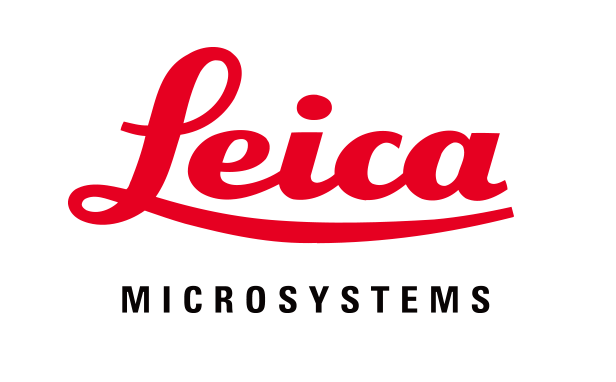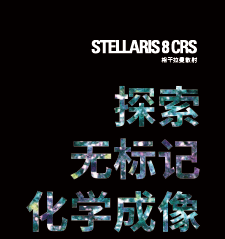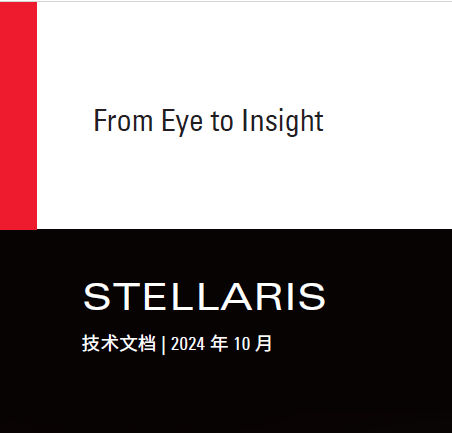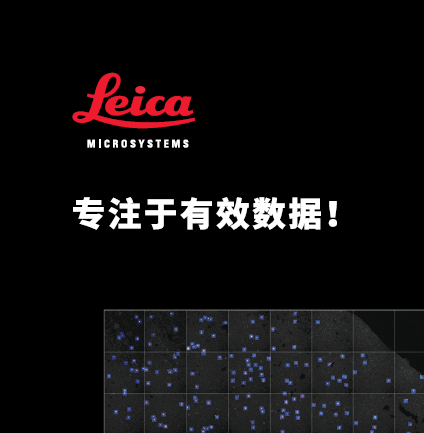使用MARS受激拉曼探针和组织透明化技术实现组织多靶标三维立体成像

在组织中研究多种蛋白质的空间位置关系,尤其是在三维组织中,在相当多的生物医学研究中都有非常重要的意义。但是荧光多重标记技术存在诸多限制,并且目前能实现多重标记的方法都只支持使用薄的组织切片(<100μm)。这篇文章的研究者利用了受激拉曼光谱成像检测光谱比较窄,不易产生信号串扰的优点,在透明化组织成像中引入了特殊的地中海拉曼探针,对厚达1mm的组织进行了一次性多靶标成像。
受激拉曼显微技术检测光谱比较窄、信号不容易产生串扰,但是其信号比传统的荧光信号强度弱,常规方法很难检测到。研究者结合电子预共振光谱(electronic pre resonance spectroscopy)和受激拉曼显微技术(Stimulated Ramen Scattering microscopy),可以使染料的拉曼吸收截面增加1013倍,弥补了拉曼信号弱、很难检测的缺点。研究者设计了地中海拉曼检测探针(MARS)结合优化的透明化技术(rDISCO: Raman 3D imaging of solvent -cleared organs),达到了在1mm厚的组织上11种靶标的同时成像。
首先,研究者设计了地中海拉曼探针MARS。MARS探针使用π形连接的三键产生电子放大,可以使染料的拉曼吸收截面增加1013倍,弥补了拉曼信号弱、很难检测的缺点。在生物细胞中MARS受激拉曼检测光谱为1800-57500px-1。因为所有的透明化试剂在2000-60000px-1光谱范围内都不产生信号,所以没有背景。NHS Ester是常用可以和探针结合的活性基团,已知有4种已经连接了NHS Ester 的MARS探针,研究者新研发了另外四种与NHS Ester 连接的MARS探针,它们和已知的四种地中海拉曼探针在核心原子、环状结构数量、与氮原子的结合方式上存在差异。图1显示了它们的化学结构和光谱特性。


图1 地中海拉曼探针


图 2 c tubulin成像 d 免疫荧光和SRS图像的比较 g 薄脑片的12种靶标同时成像。
Fluorescence: DNA (DAPI), vesicular glutamate transporter 1 (VGluT1-Alexa Fluor 488, glutamatergic neurons, direct immunolabeling), tyrosine hydroxylase (TH-Alexa Fluor 594, dopaminergic neurons, direct immunolabeling) and F-actin (Phalloidin-Alexa Fluor 647); epr-SRS: neuronal nuclei (NeuN; neurons, MARS2228), α-tubulin-MARS2176 (direct immunolabeling), calbindin (CB;
Purkinje neurons, MARS2145), β-III-tubulin (TUBB3; neurons, MARS2200), wheat germ agglutinin (WGA; MARS2242), GABA (γ-aminobutyric acid) B receptor 2 (GABBR2; GABAergic neurons, MARS2212), myelin basic protein (MBP; oligodendrocytes, MARS2188) and GFAP (astrocytes and neural stem cells, MARS2159).
使用这些MARS探针和抗体结合后,可以对组织内不同的蛋白质进行成像。与传统的免疫荧光图像类似(图2c)。这种方法可用于石蜡和冰冻组织切片的成像。将MARS探针连接lectin就可以看到细胞的膜结构,因为探针的检测光谱很窄,只有12 cm-1,这样就可以实现多个不同的拉曼探针同时成像。因此,研究者在小鼠脑切片上标记了12种marker(8种MARS和4种荧光,图2g),可以识别出脑片中的不同细胞,包括神经元颗粒细胞、星形胶质细胞、单树突细胞等。
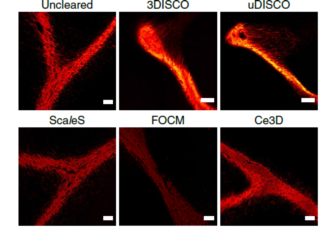
图3 各种透明化方法的SRS成像效果,其中uDISCO方法的信号最好
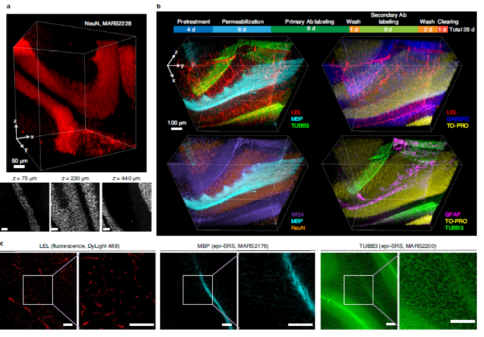
图4 Volumetric immuno-eprSRS imaging with uDISCO clearing.
a, Volume-rendered image of NeuN (granular neurons) labeled with C-cored MARS2228 in 500-μm-thick cerebellum sections cleared by uDISCO. Single-plane images show good epr-SRS contrast along the whole depth. b, One-shot eight-target volume-rendered images of a 500-μm-thick mouse cerebellum section by RADIANT. A typical workflow for tissue sample preparation, staining and clearing is depicted; Ab, antibody. Fluorescence: LEL (Lycopersicon esculentum lectin DyLight 488), TO-PRO-3 (TO-PRO; cell nucleus stain); epr-SRS: NeuN (MARS2228), TUBB3 (MARS2200), MBP (MARS2176), GABBR2 (MARS2145), WGA (MARS2242) and GFAP (MARS2159). c, Representative single-plane images with zoom-in images at z = 250 μm from the 3D data set in b; scale bars, 100 μm.
研究者还测试了不同的组织透明化方法 scale S、FOCM、Ce3D、3DISCO、 uDISCO等方法对于40-100μm厚组织切片的成像效果,发现uDISCO的成像效果最好(图3)。并且一次对8种目标(6种MARS探针和两种荧光)进行了同时成像(图4b)。
研究者还发现了透明化组织SRS成像最重要的影响因素,就是MARS探针在透明液中会产生降解。因此减少其降解,例如降温到4度或者在透明液中加入DPE和VIT E等还原剂就可以提高成像效果。研究者对一系列透明化方法进行了优化和筛选,最终发现BABB-D4+1%PG在4度下成像的效果最佳,并将这种方法命名为rDISCO (Raman 3D imaging of solvent -cleared organs)。在100μm的组织中,rDISCO成像的信噪比是uDISCO的2.6倍。
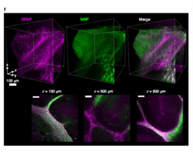
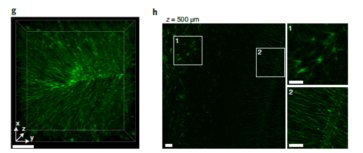
图5 Volume-rendered images of GFAP (astrocytes, labeled with MARS2145) and MBP (oligodendrocytes, labeled with Alexa Fluor 488) in 1-mm-thick cerebellum sections cleared by rDISCO. Two-color merged single-plane images show good epr-SRS and fluorescence contrast along the whole depth. g, Zoomed-in, volume-rendered images of GFAP (labeled with MARS2145) in 1-mm-thick cerebellum sections cleared by rDISCO. h, Single-plane images of g at 500-μm depth show fine spatial resolution to resolve fibral structures of astrocytes .Left, zoom-in to the regions outlined by the dashed white box.1-mm-thick samples (n = 3 ROIs).
用这种方法在1mm厚的脑片上实现了11个靶标的3D大样本深度成像,如图6。

图6 RADIANT with rDISCO clearing enables millimeter-scale, highly multiplexed protein imaging.
Eleven-target volume-endered images of a 1-mm-thick mouse cerebellum section by RADIANT with rDISCO clearing. Fluorescence: concanavalin A (ConA, Alexa Fluor 350), Griffonia simplicifolia lectin (GS-II, Alexa Fluor 488), TUBB3 (Alexa Fluor 594, direct immunolabeling), TO-PRO (cell nucleus stain); epr-SRS: NeuN (MARS2228), LEL(MARS2200), MBP (MARS2176), GABBR2 (MARS2145), WGA (MARS2242), vimentin (Vim, MARS2212) and GFAP (MARS2159).
这项研究结合了电子预共振光谱(electronic pre resonance spectroscopy)和受激拉曼显微技术(Stimulated Ramen Scattering microscopy),利用特殊设计的MARS探针和优化的组织透明化方法实现了在1mm脑片的11种靶标的一次性成像。这项技术在未来的生物医学上会有非常广阔的应用前景。
Leica STELLARIS CRS 系统是一套方便快捷的多模态受激拉曼光谱成像系统,商品化的受激拉曼成像系统,无需为了保证光路的正确而花很多时间去调整它,您可以专注于生物学成像,系统同时兼顾了受激拉曼成像、单光子、多光子、二次谐波、三次谐波成像,对于上述的组织三维多靶标受激拉曼成像是非常适合的研究工具。
参考文献:
Lixue Shi et al. Highly-multiplexed volumetric mapping with Raman dye imaging and tissue clearing, Nature Biotechnology. https://doi.org/10.1038/ s41587-021-01041-z.






